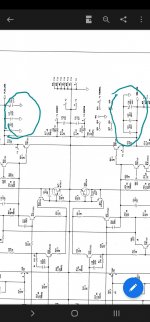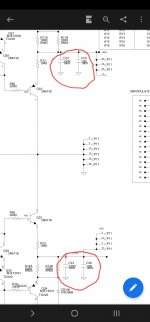Hi Chris
Thanks for everything.
Here is the thing those resistors connected straight to the binding post. Just to be sure I have tested it with my fluke
Beside of that to avoiding high frequency oscillation there are two RC networks please see R60-R61-R1001-C91 and the other one is R160-R161-C191. (All the transistors in this networks are already non inductive vishay NS-5)
I have attached the schematic and after that if you still telling me that they are only a feedback I will not change a thing !
Otherwise I don't understand why to connect those resistors to the binding post.
BTW the 10W resistors mine is different revision and they are 0.33ohm and not 0.1ohm.
Thanks again !!!
Thanks for everything.
Here is the thing those resistors connected straight to the binding post. Just to be sure I have tested it with my fluke
Beside of that to avoiding high frequency oscillation there are two RC networks please see R60-R61-R1001-C91 and the other one is R160-R161-C191. (All the transistors in this networks are already non inductive vishay NS-5)
I have attached the schematic and after that if you still telling me that they are only a feedback I will not change a thing !
Otherwise I don't understand why to connect those resistors to the binding post.
BTW the 10W resistors mine is different revision and they are 0.33ohm and not 0.1ohm.
Thanks again !!!
Attachments
Last edited:
Hi xrk971,
Well, had you asked me that when I had my shop I would have been able to produce the required equipment lists. They were also required from every verbal communication I had with service managers. They were in use in every single service area. I don't know about the cheaper brands, But Marantz, Carver and every other quality brand I did required them. When I had them, my equipment lists were approved without question. Even today, if asked, the loads I have are given instant clearance.
I'm actually a bit stunned that you are asking. This is something you ought to have run into much earlier on.
The last time I bought them, they cost about $60 each. The first time, they cost me about $50 ($40 and change) a piece. Geez, they have gone up a lot. They are $235.11 Canadian. I used to buy them from Digikey and earlier, Electrosonic.
They do list a 4R resistor for $48.39 that is similar, Ohmite HS2504RF. HS2504RF OHMITE | Electro Sonic and the data sheet is :HS2504RF-OHMITE-Datasheet
If you read the data sheet you will see that you can order 8R 1% low inductance. So this would seem to be a reasonable solution for a dummy load. Don't forget that they need to mount flat. Every heat sink I got was not flat on the non-fin side and I had to have each milled so that I could mount them safely.
Even with this preparation, we managed to blow a few over the years. I put thermal monitors into my current setup on my bench. I just need to wire it up with a power source now.
-Chris
Well, had you asked me that when I had my shop I would have been able to produce the required equipment lists. They were also required from every verbal communication I had with service managers. They were in use in every single service area. I don't know about the cheaper brands, But Marantz, Carver and every other quality brand I did required them. When I had them, my equipment lists were approved without question. Even today, if asked, the loads I have are given instant clearance.
I'm actually a bit stunned that you are asking. This is something you ought to have run into much earlier on.
The last time I bought them, they cost about $60 each. The first time, they cost me about $50 ($40 and change) a piece. Geez, they have gone up a lot. They are $235.11 Canadian. I used to buy them from Digikey and earlier, Electrosonic.
They do list a 4R resistor for $48.39 that is similar, Ohmite HS2504RF. HS2504RF OHMITE | Electro Sonic and the data sheet is :HS2504RF-OHMITE-Datasheet
If you read the data sheet you will see that you can order 8R 1% low inductance. So this would seem to be a reasonable solution for a dummy load. Don't forget that they need to mount flat. Every heat sink I got was not flat on the non-fin side and I had to have each milled so that I could mount them safely.
Even with this preparation, we managed to blow a few over the years. I put thermal monitors into my current setup on my bench. I just need to wire it up with a power source now.
-Chris
Hi Nehoray,
Those are simple series resistors, and I don't know why they need them. They are unusual for an amplifier design. The zobel networks you are describing (series R-C from output to ground) provide some load at high frequencies for stability.
Do not mess with what they have done. There is a reason why each part type was specified and I learned long ago not to second guess a design engineer - unless the design had problems (like oscillation).
I can't take the time to explain to you why changing the resistor type will not affect the sound beyond telling you they are inside the feedback loop. Other components determine what the amp will sound like. Trust me, its true - within reason of course!
-Chris
Those are simple series resistors, and I don't know why they need them. They are unusual for an amplifier design. The zobel networks you are describing (series R-C from output to ground) provide some load at high frequencies for stability.
Do not mess with what they have done. There is a reason why each part type was specified and I learned long ago not to second guess a design engineer - unless the design had problems (like oscillation).
I can't take the time to explain to you why changing the resistor type will not affect the sound beyond telling you they are inside the feedback loop. Other components determine what the amp will sound like. Trust me, its true - within reason of course!
-Chris
Thanks for the info Chris. Note that the prefix N has to be added to the above HS... part number when ordering to get non inductive. That changes the way they are wound and the nominal resistance is divided by 4 according to the data sheet.
I do work with several major manufacturers and they are fine with the EBG UXP 300 resistors I am using. Those are in fact machined flat and have a huge heatsink surface of about 2in 2in flat aluminum. They are pricey too but can be found surplus for about $10.
The UXP-350 (replaces the UXP-300) is rated for 350w, 5kV, and has 80nH inductance. There is also the HXP series good for 200w in an isotop style with several flexible connections to achieve different values.
https://www.ebg-resistors.com/fileadmin/user_upload/EBG/Products/EBG_Product_Catalog_2020_Web.pdf
I do work with several major manufacturers and they are fine with the EBG UXP 300 resistors I am using. Those are in fact machined flat and have a huge heatsink surface of about 2in 2in flat aluminum. They are pricey too but can be found surplus for about $10.
The UXP-350 (replaces the UXP-300) is rated for 350w, 5kV, and has 80nH inductance. There is also the HXP series good for 200w in an isotop style with several flexible connections to achieve different values.
https://www.ebg-resistors.com/fileadmin/user_upload/EBG/Products/EBG_Product_Catalog_2020_Web.pdf
Hi guys
I need your help in order to understand something
I tried to understand the differences between the no 33 and the 33H
And one of the differences is in the voltage regulation circuit that supply the input stage
At the end of the circuit you can see 2 electrolytic capacitors of 100V 330uf while in the 33H there isn't any...
Why is that ???
I need your help in order to understand something
I tried to understand the differences between the no 33 and the 33H
And one of the differences is in the voltage regulation circuit that supply the input stage
At the end of the circuit you can see 2 electrolytic capacitors of 100V 330uf while in the 33H there isn't any...
Why is that ???
Attachments
Hi Chris
Thank you very very much
I have marked the exact location
However the VR33JR file refers to the 33H And the REG 941031B refers to the 33
Thank you very very much
I have marked the exact location
However the VR33JR file refers to the 33H And the REG 941031B refers to the 33
Attachments
Hi Montana,
Those parts are completely non-critical in value. The small values provide low high frequency impedance and the large ones give you a low impedance across most of the audio band. If they weren't there at all the amplifier might motorboat or oscillate, butall you need are reasonable capacitance values.
You might see this as a running production change where the circuit doesn't match the schematic in this way. In any event, no big deal.
-Chris
Those parts are completely non-critical in value. The small values provide low high frequency impedance and the large ones give you a low impedance across most of the audio band. If they weren't there at all the amplifier might motorboat or oscillate, butall you need are reasonable capacitance values.
You might see this as a running production change where the circuit doesn't match the schematic in this way. In any event, no big deal.
-Chris
Hi nehoray,
Okay, no problem. They simply discovered they didn't need the large bulk capacitance and saved a little money by not installing it. The choice may or may not have been wise under all conditions, but I can't say without having one on the bench. Alternatively, a new board layout may have made the larger capacitor unnecessary.
There are any number of reasons why that part was excluded from the design. The smaller ones likely are what was needed to solve the problem. If the 330uF was in the earlier design, it was installed just for good design practice. If it was the other way around, they discovered they needed it.
In short, I wouldn't be too worried about it. Assume the design is stable since they are a commercial design unless you experience problems.
-Chris
Okay, no problem. They simply discovered they didn't need the large bulk capacitance and saved a little money by not installing it. The choice may or may not have been wise under all conditions, but I can't say without having one on the bench. Alternatively, a new board layout may have made the larger capacitor unnecessary.
There are any number of reasons why that part was excluded from the design. The smaller ones likely are what was needed to solve the problem. If the 330uF was in the earlier design, it was installed just for good design practice. If it was the other way around, they discovered they needed it.
In short, I wouldn't be too worried about it. Assume the design is stable since they are a commercial design unless you experience problems.
-Chris
- Home
- Amplifiers
- Solid State
- Low noise Emmiter resistors

